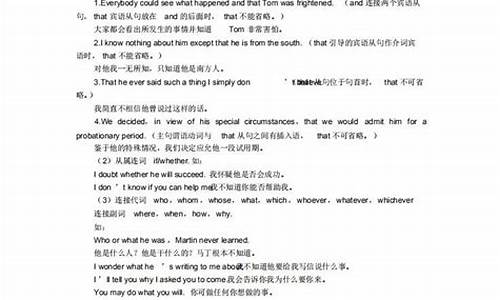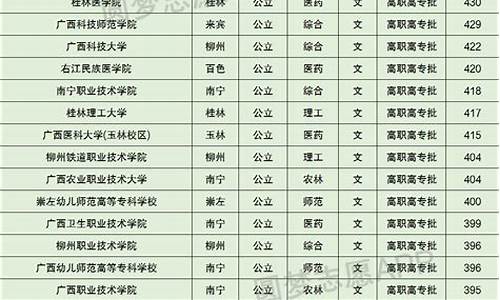您现在的位置是: 首页 > 教育比较 教育比较
高考英语定语_高考英语定语从句真题及答案
tamoadmin 2024-05-26 人已围观
简介1.高考英语。宾语从句和定语从句有什么区别呢,求简单讲解下重点2.2011届高三英语定语从句第一轮复习语法3.高中英语定语从句说课稿4.高考英语语法:由关系副词when,where,why引导的定语考点一 考查关系代词whose引导的定语从句 1. A person ________ e-mail account is full won’t be able to send or receive a
1.高考英语。宾语从句和定语从句有什么区别呢,求简单讲解下重点
2.2011届高三英语定语从句第一轮复习语法
3.高中英语定语从句说课稿
4.高考英语语法:由关系副词when,where,why引导的定语

考点一 考查关系代词whose引导的定语从句
1. A person ________ e-mail account is full won’t be able to send or receive any e-mails. (天津卷)
A. who B. whom C. whose D. whoever
解析C。在所给的四个关系代词中,只有whose能用于名词用作定语,故选C。又如:A bookseller is a person whose job is selling books. 书商就是其职业是卖书的人。
2. Many children, ________ parents are away working in big cities, are taken good care of in the village. (安徽卷)
A. their B. whose C. of them D. with whom
解析B。their是物主代词,不是关系代词,不能引导定语从句,所以不能选;在其余三个选项中,只有whose能用于名词用作定语,故选B。句意为:许多孩子的父母外出到大城市打工去了,他们在家乡被照顾得很好。
3. I was born in New Orleans, Louisiana, a city ________ name will create a picture of beautiful trees and green grass in our mind. (湖南卷)
A. which B. of which C. that D. whose
解析D。在所给定的四个关系代词中,只有which和whose能用于名词用作定语,故可排除B和C。而关系代词which和whose用于名词前作定语的区别是:which具有that或this的语义特征,而whose则具有one’s的语义特征。
考点二 考查关系代词which引导的定语从句
1. They’ve won their last three matches, ________ I find a bit surprising. (辽宁卷)
A. that B. when C. what D. which
解析D。that不用于引导非限制性定语从句,故被排除;when可引导非限制性定语从句,但只用于指时间,与句意不符,故也被排除;而what不是关系代词,不能用于引导定语从句,故也被排除;which在此引导非限制性定语从句,并在定语从句中充当动词find的宾语。句意为:他们赢了最后三场比赛,我发现这有点令人吃惊。
2. My friend showed me round the town, ________ was very kind of him. (全国Ⅱ)
A. which B. that C. where D. it
解析A。由于两个句子之间没有并列连词,所以不能选B或D;而where是关系副词,不能用作主语;which在此引导非限制性定语从句,并在从句中用作主语。又如:Peter drove too fast, which was dangerous. 彼得开车很快,这是很危险的。
3. Whenever I met her, ________ was fairly often, she greeted me with a sweet smile. (山东卷)
A. who B. which C. when D. that
解析B。that不能用于引导非限制性定语从句,故可排除;when是关系副词,不用作主语,故也可排除;who用于指人,但这里的定语从句不是修饰her,而是修饰whenever I met her,故不能用who,此处应用which。又如:He said that he had never seen her before, which was not true. 他说他从没见到过她,这是不真实的。
高考英语。宾语从句和定语从句有什么区别呢,求简单讲解下重点
高中语法主要有主谓一致、冠词、代词、连词、介词、动词短语、情态动词、时态语态、虚拟语气、非谓语动词、形容词、副词、名词、动词、从句等。
高考英语语法考点
一、定语从考点
1.which引导的代表整个主句内容的非限制性定语从句which引导非限制性定语从句时可代表主句内容,前面有逗号与主句隔开。
例句:The CCTV’s 2010 Entertainment Party was successfullyheld on the evening of February 13th,2010, which wasanother great encouragement to all the Chinese.中央电视台2010年春节文娱晚会于2010年2月13日晚成功举行,这对全体中国人民来说又是一个巨大的鼓舞。
2.特定词汇+of whom ,which引导的非限制性定语从句介词(包括复杂介词),数词(包括数量代词)及其它含局部与整体关系的特定词~E+of whom(指人)/which(指物)可以引导非限制性定语从句,此时前面不可加and,but等连词,该结构也可改为of whom /which+特定词汇引导定语从句。
例句:Our English teacher has three daughters,all of whom /ofwhom all are considerate.
我们的英语老师有三个女儿,个个都很善解人意
3.由when.where引导的先行词隐蔽度比较高的定语从句历年的高考考查实践表明,增加定语从句难度的手段之一是增加先行词的隐蔽度,如用point,case,situation等抽象的地点名词做先行词,当其在定语从句中做地点状语时用where引导定语从句的判断难度会增加,用occasion,period等表示抽象时间的名词做先行词,当其在定语从句中做时间状语时用when引导定语从句的判别难度也会增加。
例句:I’m sorry that I can’t think out a situation where thiskind of deion is used.
对不起我想不出这种描绘被使用的场合。
二、名词性从句考点
1.what引导的名词性从句
what可引导名词性从句,表示“. ·-的内容(人、时间、地点、价格、速度、方式等)”。The Great Wall of China is what I most want to visit.长城是我最想参观的地方。
2. that引导的同位语从句
that可引导同位语从句,说明被修饰名词的内容。
例句:Word hascome that the sports meeting will be put of.
有消息说运动会将被推迟。
3.whatever.whoever引导的名词性从句 whatever和whoever可引导名词Jl生从句,前者表示“无论什么 ,后者表示“不管谁 。
例句:You can give the book to whoever you think needs it.
你可以把这本书给任何你认为需要这本书的人。
4.whether,if引导的名词性从句
if只可引导宾语从句且不能和or not连用。whether可引导各种名词性从句且可和or not连用。
例句:When shall we discuss the question whether we will havea picnic next week?
我们什么时候讨论下周是否搞一次野餐的问题?
三、状语从句考点
1.where引导的地点状语从句
where可引导地点状语从句,表示“在..的地方 。0ur school lies where there is a small river.我们学校位于有一条小河的地方。
2.before引导的时间状语从句
before引导时间状语从句时可表示“在..之前,尚未来得及,趁 。
例句:Thenaughty boy had run away before I could call him tostop.
我还没有来得及叫住他,这个调皮男孩就跑开了。
3.unless.as/so long as引导的条件状语从句
unless,as/so long as可弓I导条件状语从句,前者表示。除非 ,后者表示“只要 。
例句:As/So long as you treat them truly,you can win overtheir respect.
只要你真诚地对待他们,你会赢得他们的尊敬。
4 . so that.in case引导的目的状语从句
so that,in ease可引导目的状语从旬,前者表示“以便”,后者表示“以免 。
例句:Please close all the doors and windows in ease it willrain.
请关上所有门窗,以防天会下雨。
5.while引导的让步状语从句
while可引导让步状语从句,表示“尽管”。
例句:While this problem is very difficult,it is very important.
尽管这道题很难,却很重要。
四、情态动词考点
1.推测性情态动词用法
may(可许,可能),might(可许,可能),must(一定,必定),can(或许,可能)均有推测性用法,其中might可能性最小,must可能性最大。may,might,must常用于肯定句,may,might用于否定句可表示“可能不 ,can常用于否定句和疑问句,用于否定句表示 不可能 。
例句:— — Can the man standing there be OUY physics teacher?
— — No.he can’t be our physics teacher.
— — 站在那边的那个人可能是我们的物理老师吗?
— — 不,不可能。
2.should的用法
should常表示“应该”,但可置于句首用于条件状语从句(省去if),表示。万一 ,还可表示 竟然
例句:Should you see the thiel,try to catch him.如果你见到小偷,尽量捉住他。
3.may,must,earl’t,should (shouldn’t),ought to(oughtn’tto).needn’t的完成式用法mav have done表示“可能已经做了某事 ,must have done表示“一定已经做了某事”,can’t have done表示“不可能已经做了某事”,should/ought to have done表示“本来应该做某事但实际未做 ,shouldn’t/oughtn’t to have done表示 本来不应该做某事但实际已做”,Ileedn’t have done表示“本来没有必要做某事但实际已做”。
例句:Our Chinese teacher isn’t in her offlee,so she may /might/must have gone home.
我们的语文老师不在办公室,所以她可能/-~定回家了。
五、倒装句型考点
1.完全倒装句型考点
地点状语置于句首时需要使用完全倒装句型,将动词直接提前。
例句:At the back of our school stands a high tower.
我们学校后面矗立着一座高塔。
SO(肯定句中表示“也”),neither,IOF(否定旬中表示“也”),80.that. (引导结果状语从句)j only(不修饰主句),no[only.but also. (不连接主语,连接两个分旬时第一个分旬倒装,第二个分句不倒装),not until,Never,hardly,little,hardly.when., SO SO01qe/"than,not a,nowhere,in no ease等词或短语置于句首时应使用不完全倒装句型。
例句:Only then did we realize the harm of pollution.
只有在那时我们才意识到污染的危害。
2.as引导的特殊倒装句型
as引导让步状语从句时可将表语、动词、副词提前,将as紧随其后。如果表语为单数可数名词,提前时应去掉不定冠词。
例句:Weak as she was,she still went on working.
尽管她身体虚弱,仍继续工作。
六、虚拟语气考点
1.与过去事实相反的if虚拟条件状语从句与过去事实相反时,从句动词用had done,主句动词用would,could,should,might have done,当从句动词含有were,had,could,should时可将其提至句首将if省略。
例句:Had I known it at that time,I would have told you.
如果那时我知道这件事一定告诉了你。
2.混合虚拟条件从句
如果if虚拟条件状语主从句时态不一致,应根据各自所体现的时间关系加以适当的调整,采用不同的动词形式。
例句:If she had told me her telephone number yesterday,Icould phone her now.
如果她昨天把她的电话号码告诉了我,我现在就可以给她打电话了。
3.with.without.but for引导的含蓄虚拟条件从句with,without,but for可取代if引导含蓄虚拟条件从句。
例句:With your help,I could have made more achievements.
如果得到你的帮助,我一定会取得更多成就。
4.wish引导的表示过去主观愿望的宾语从句
wish引导宾语从句时如果表示过去的主观愿望,从句动词应用had done或could have done。
例句:I wish I had /could have watched that basketball matchyesterdayafternoon.
我希望我昨天下午看了那场篮球赛。
5.insist,suggest引导的宾语从句
insist,suggest接宾语从若表示建议应用虚拟语气,动词形式为(should)do,但如果insist表示 坚持认为,固执己见 ,suggest表示。表明、暗示 ,所在宾语从句应用陈述语气。
例句:Thedoctor insisted that the patient was seriously ill and(should)be 0Dcrated 0n at once. 医生坚持认为病人病得很严重,建议其立即做手术。
七、不定式考点
1.不定式做目的状语
不定式可做目的状语,如果对其强调可将其提至句首,此时应注意人称一致。
为了及时赶到那里,她将自行车骑得很快。
误:T0 get there in time.her bike waS ridden fast.
正:To get there in time.she rode her bike fast.
2.不定式做结果状语
不定式可做结果状语,强调出乎意料的动作,此时前面可加onlyo
例句:I went to see her to find her absent.
我去看她结果发现她不在家。
3.不定式的复杂形式
不定式除有一般式外,还有否定式not to do,进行式to bedoing、完成式to have done、被动式to be done、完成被动式tohave beendone等复杂形式。
例句;All the employees worked hard not to be fired.
为了不被解雇,所有的员工努力工作。
4.不定式独立主格结构
with+名词+不定式可构成独立主格结构做状语,表示未来的动作。
例句:Witha lot of work to do,I can’t help you at present.
因为有许多工作要做,我现在不能帮助你。
八、V—ing形式考点
1.V—ing形式做宾语
excuse. f0r. ,can’t help,suggest,include,insist on,keep on, consider, finish, practice, put off, postpone, delay,miss,avoid,give up,imagine,feel like,enjoy,risk,mind,appreciate,stand,escape等词后面只能接V—ing形式做宾语。remember 得曾做某事),forget(忘了曾做某事),mean(意谓着),try(尝试),regret (后悔),go on (继续做同一件事),stop(停止做某事),need(主语需要被..)等词表示括号内的含义时也应接v—ing形式做宾语。
例句:The hare was lucky enough to have avoided being caught.
这只野兔很幸运,错过了被捉住。
2.V—ing形式做定语
V—ing形式做定语可表示被修饰名词的的用途和性质,也可表示正在进行的动作。
例句:The great noise comes from the building being built now.
这巨大的噪音来自正在被建的楼房。
3.V—ing形式做状语
V—ing形式做状语常表示动作正在进行,此时应注意它的逻辑主语为主句主语。
例句:Holding a book in his hand,he came into the room.
他手里拿着一本书走进了房间。
4. V—ing形式做宾语补足语
V—ing形式做宾语补足语也表示动作正在进行。
例句:WhenI came to the five~ide.I f0und girl struggling inthe water.
来到河边时我看见一个女孩在水中挣扎。
5. V—ing形式独立主格结构
with+名词+V—ing形式可构成独立主格结构做状语,表示正在进行的动作。
例句:With the water still rising,the villages couldn’t return totheir village.
因为水位还在上涨,村民们无法回到村里。
6.V—ing形式复杂形式
V—ing形式除有一般式外还有完成式having done,被动式being done,完成被动式having been done,否定式not doing,完成否定式not having done,完成被动式的否定式not havingbeen done。
例句:Havingsaid goodbye to each other, the children wenthome.
彼此说了再见之后,孩子们回家了。
九、过去分词考点猜想
1.过去分词做状语
过去分词做状语常表示被动的动作,也可因来自系表结构而表示主动的动作。
例句:Caught in a heavy rain,the girl was all wet.
因为被浇了一场大雨,这女孩浑身湿透了。
2.过去分词独立主格结构
with+名词+过去分词可构成独立主格结构做状语,表示被动的动作。
例句:With his homework finished, the boy went out to getrelaxed.
因为家庭作业完成了,这个男孩出去放松了一下。
2011届高三英语定语从句第一轮复习语法
答如下:
1. 宾语从句置于及物动词或介词之后,作动词或介词的宾语。引导宾语从句的词有连接词(that, if, whether) 、连接代词(what , which, who, whom, whose等)和连接副词how, when, where, why等)。例如:
I know that he is ill.
Can you tell me where he lives?
I wonder if / whether he will go.
We don't know whose wallet it is.
Tom is interested in what you said.
注意:that或if从句通常不作介词的宾语(except除外)。例如:
I am not sure about whether (不用if) he will go.
The house is beautiful except that it is a little small.
2. 定语从句置于所修饰的名词或代词之后 ,它在句中用来作定语,修饰前面的名词。被定语从句修饰的名词叫先行词。引导定语从句的词有关系代词(that , which,who, whom, whose等)和关系副词(when, where, why等)。关系代词指代前面的名词,在定语从句中可以作主语、宾语和定语; 关系副词在定语从句中可以作状语,表示时间、原因、地点等。
I know the man who / that is standing there.
The novel which / that you bought is fun.
That is the house where he lived in.
I will never forget the day when I
高中英语定语从句说课稿
定义
I. 定语从句起形容词的作用,在句中修饰一个名词或代词。被修饰的词叫做先行词,引导定语从句的词叫关系词,他的作用一是放在先行词与定语从句中间起了连接作用,二是在从句中担当一个成分,并与先行词保持数的一致。
关系词 先行词 从句
成分 例句 备注
关系代词 who 人 主语 Do you know the man who is talking with your mother? whom, which和that在从句中做宾语时,常可以省略,但介词提前时后面关系代词不能省略,也不可以用that
whom 人 宾语 Mr. Smith is the person with whom I am working
The boy (whom) she loved died in the war..
whose 人,物 定语 I like those books whose topics are about history.
The boy whose father works abroad is my desk mate.
that 人,物 主语
宾语 A plane is a machine that can fly.
She is the pop star (that) I want to see very much.
which 物 主语
宾语 The book (which) I gave you was worth $10.
The picture which was about the accident was terrible.
as 人,物 主语
宾语 He is such a person as is respected by all of us.
This is the same pen as I lost yesterday. as做宾语一般不省略
关系副词 when 时间 时间
状语 I will never forget the day when we met there. 可用on which
where 地点 地点
状语 This is the house where I was born. 可用in which
why 原因 原因
状语 I can’t imagine the reason why he turned down my offer. 可用for which
Ⅱ. as与which的区别:
定语
从句 区别 例句
限制性定语从句 中 名词前有such和the same修饰时,关系代词用as,不能用which He is not such a fool as he looks.
Don’t read such books as you can’t understand.
非限制性定语从句中 as和which都可以指代前面整个主句。如果有“正如,象”的含义,并可以放在主句前,也可以放在后面,那么用as;而which引导的从句只能放主句后,并无“正如”的意思。 They won the game, as we had expected.
They won the game, which we hadn’t expected.
As is well known, he is a famous film star in the 1980s.
Ⅲ. 限制性定语从句与非限制性定语从句的区别:
类别 语法意义及特征 例句
限制性定语从句 对先行词起修饰限制作用,如果去掉,主句意思就不完整明确,这种从句与主句的关系十分密切,写时不用逗号分开。 The accident happened at the time when I left.
非限制性定语从句 对先行词作附加的说明,与主句的关系不十分密切,较松散。从句和主句之间用逗号分开,相当于一个插入语,不能用that引导,关系代词做宾语时也不能省略。 His mother, whom he loved deeply, died ten years ago.
一、考点聚焦
1、功能:相当于形容词,修饰名词或代词,在句中作定语
2、位置:定语从句置于被修饰词之后
Those who are willing to attend the party, sign here please.
3、先行词:被定语从句修饰的词称为先行词
(1)先行词一般是名词和不定代词,如:some-, any-, every-和no与-boy, -thing的合成词;或all、none、any、some、that、those等代词。数词也可以作先行词,人称代词也同样可作先行词。
(2)先行词与关系词是等量关系。必须注意两点:
①先行词在从句中作主语时,从句谓语动词的数由先行词而定。
This is the place which is worth visiting.
②关系词在从句句子中充当了成分,其意思就是先行词的意义,所以在从句中不能重复其意。
There are many places we can visit(them)in China.
4、关系词:引导定语从句的都称关系词
关系代词:who, whom, which, that, whose, as。
关系副词:when, where, why。that偶尔也作关系副词。
5、确定关系词的步骤
(1)先找关系词,看先行词指的是什么。
(2)看关系词在从句中所充当的成分。
6、在定语从句中,当先行词指物时,下列情况的关系词宜用that而不用which
(1)先行词被①形容词最高级 ②序数词 ③数词几种词修饰或被 ④only、any、few、little、no、all、one of等修饰时。
(2)先行词为all、much、little、none、few、one、something、anything等不定代词时。
(3)先行词中既有人又有物时。
He was looking pleasantly at te children and parcels that filled his bus.
(4)先行词在主句中作表语关系词在从句中作表语时。
The village is no longer the one that was 5 years ago.
(5)当主句中含有疑问词which时。
Which are the books that you bought for me ?
7、宜用which而不用that的情况
(1)在非限制性定语从句中
(2)在关系词前有介词时
(3)当先行词本身是that时
(4)当关系词离先行词较远时
8、关系词who与that指人时,也有不同情况分别用不同的关系词
(1)当主句是there be句型时,关系词用who。
(2)先行词是为anyone、those、someone、everyone、one等词时,关系词用who。
(3)当主句是who作疑问词时,关系词用that。
Who is that girl that is standing by the window?
(4)whom在从句中只作宾语,可被who取代。
9、whose作关系词既指人又指物,在从句中作定语。如:
Do you know Mr. Smith whose story is very moving?
There is a room, whose window faces the river.
There is a room, the window of which faces the river.
10、关系代词as,在从句中作主语、宾语和表语。
(1)先行词被such和the same修饰,或句型as many(much)中,从句都用as 引导。
Such books as you bought are useful. The school is just the same as it was 10 years age.
注意:区别①such … that … 引导的结果状语从句。They are such lovely children that we love them much .②the same … that … 引导定语从句。I want to use the same tool that you used just now.
(2)无先行词的定语从句用as和which引导。
区别:①意义上:as 含有“这点正如……一样”。②位置上:as 从句可置句首,也可在另处。
He didn’t pass the exam, as we had expected.
There is lots of air in loose snow, which can keep the cold out.
As is known, the earth is round, not flat.
11、关系副词when与where、why、that
when 指时间 = in / at / on / during which
where指地点 = in / at / from / which
why指原因 = for which
当先行词为way、day、reason、time时,可用that作关系副词。(非正式场合)
I don’t like the way that / in which / he talks.
当time作先行词时,关系词可以省掉。
This is the first time I have given you a lesson in French.
12、必须注意的问题
(1)关系词作主语时,从句中谓语的数。
(2)注意区别定语从句与强调句。
①定语从句中关系词作从句成分,复合句。
②强调it无意义,that / who不是引导词。
③强调it is / was和that / who后如果句子意思讲得通则是强调句,讲不通则不是。
It is the museum that / which we visited last year.(定语从句)
It was in the hotel that we stayed last night.(强调句)
(3)定语从句与同位语从句的区别。
①定语从句引导词被称为关系词,that充当主语、宾语、表语。有时可省略。
②同位语从句引导词被叫做连词,that不能充当任何成分,不可省。
Word came that their army was defeated.(同位语)
We expressed to them our wish that was the same as their.(定语)
(4)关系词在从句中省略的情况。
①关系词作宾语,前无介词时。
②关系词作表语。
(5)限制性定语从句与非限制性定语从句的翻译。
(6)关系词前有介词或复杂介词,关系词只能是which和whom。
(7)几个特殊的定语从句句型:
①He is the only one of the students who has got very good marks in the match.(句中one为先行词)
He is one of the students who have got good marks in the match.(句中students为先行词)
②Is this place the one (that) we visited yesterday? Is this the place (that / which) we visited yesterday?
③He stood at the window, from where he could see what was happening.
④It may rain, in which case the match will be put off.
二、精典名题导解
1. The film brought the hours back to me _________ I was taken good care of in that faraway village.(NMET 2001)
A. until B. that C. when D. where
解析:答案为C。本题考查分隔定语从句的关系词的选择。作好本题的关键是要能辨认出该定语从句的先行词the hours和关系词被介词短语to me所分隔。定语从句的先行词是表时间的名词hours, 并且关系词在从句中用作状语,故应选择表示时间的关系副词when。
2. ___________ is known to everybody, the noon travels around the earth once every month.(NMET 2001)
A. It B. As C. That D. What
解析:答案为B。本题考查as引导的非限制定语从句。as作“正如……”解时,引导的非限制性定语从句来修饰整个句子。当as在从句中作主语时,常用于下列短语:as is known、as is said、as is reported、as is announced等。要注意掌握作关系代词引导定语从句的用法。
3. After living in Pairs for fifty years he returned to the small town ___________ he grew up as a child.(NMET 1996)
A. which B. where C. that D. when
解析:答案为B。本题考查限制性定语从句中关系词的选择。定语从句的先行词是表示地点的名词短语the small town, 且关系词不作定语从句中的主语和宾语而作地点状语,因此定语从句必须用关系副词where引导。要注意分清先行词在从句中充当的成分,然后选择适当的关系词。
高考英语语法:由关系副词when,where,why引导的定语
高中英语定语从句说课稿
定语从句(Attributive Clauses)在句中做定语,修饰一个名词或代词。它是高中英语学习的重要语法项目之一,也是历年高考的热点。如下是我给大家整理的高中英语定语从句说课稿,希望对大家有所作用。
Ⅰ.概念:
(1) 定语从句:在主从复合句中用作定语的从句叫定语从句。定语从句一般紧接在先行词后面。
(2) 先行词:被定语从句修饰的成份。先行词可以为一个词,短语,或整个主句。
(3) 引导定语从句的词叫关系词,分为关系代词和关系副词。
关系词的作用:
1) 引导定语从句,连接主句和从句,相当于一个连词;
2) 必在从句中作某个句子成份(可以做主语,宾语,表语,定语,状语)
常用的关系代词: that、 which、 who、whom、as , 在从句中作主语,宾语,whose在从句中作定语)
常用的关系副词(在从句中只作状语): when、why、 where
The student who answered the question was John.
I know the reason why he was so angry.
The boy (whom) you are talking to is my brother.
I'd like a room whose window looks out over the sea.
定语从句三步:
第一找出先行词;
第二看先行词在定语从句中的语法功能(做主语、宾语或状语);
第三选择合适的关系词。
Ⅱ. 几个关系代词的基本用法:
●that: 可指人或物;在定语从句中作主语,宾语,表语。(指人时,相当于who或 whom;指物时,相当于which)(不用于非限制性定语从句; 不可置于介词后作宾语) 如:
1. Do you know the gentleman that/who spoke just now?
2. You can take anything ( that) you like.
3. What is the question (that/which) they are talking about?
4. Here is the man ( who/whom/that ) you want to see.
5. She's no longer the girl ( that) she used to be before.
●which: 指物;在定语从句中作主语,宾语,表语,定语。如:
1. The bookwhich/that was on the desk was bought by my father.
2. The book (which/that) I bought yesterday is very interesting.
3. The factory in which his father works is far from here.
●who, whom, whose:
who: 主格, 在从句中作主语,在口语或非正式用法中作宾语; 只可指人
whom: 宾格,在从句中作宾语; 只可指人
whose: 属格,在从句中作定语,可指人也可指物。
1. I like the students who/that work hard.
2. All who heard the story were amazed.
(代词如he, they, any, those, all, one等后多用who.)
3. He's a man from whom we should learn.
= He's a man (whom/who/that) we should learn from.
4. A child whose parents are dead is called an orphan.
5. I'd like a room whose window faces south.
=I'd like a room of which the window faces south.
=I'd like a room the window of which faces south.
关系代词作介词宾语: (介词+ whom / which)
关系代词在定语从句中用作介词宾语时, 介词可放于从句之首, 也可放于从句之末. 但以放于句首较为正式.(介词前置,必须注意不影响动词词组的含义。)
1. This is the book for which you asked. =This is the book (that/which) you asked for.
2. Do you know the person with whom I shook hands?
= Do you know the person (whom/who/that) I shook hands with?
3. Is this the factory to which you paid a visit last week?
4. Is this factory the one to which you paid a visit last week?
5. This is the girl whom they are looking after. (介词after与look构成固定词组,不可前置。look at, look for, look after, take care of等)
●as 的.用法:(as 引导定语从句, 在定语从句中作主语、宾语、表语)
①如为限制性的,多用于the same …as ; the same as;such …as …; as many/much as;so …as等结构中。
1. I have the same book as you (have). 我有一本和你的一样的书。
2. .---Why didn't you mention that in face of the police just now?
--- I thought it was such a minor detail as was hardly worth mentioning.
3. Don't do such things as you are not sure about.
比较:I live in the same house that he used to live in.
I'm wearing the same shirt as you wore yesterday.
比较:Here is so big a stone as no one can lift. (定语从句)
Here is so big a stone that no one can lift it.(结果状语从句)
②如为非限制性的,多单独引导一个定语从句,这种定语从句可置于句首,句中或句尾,译为"正如,这一点"。(动词常为know, see, expect, point out, etc.)
As we all know, smoking is harmful to one's health . (as 作宾语)
=As is known to all, smoking is harmful to one's health . (as 作主语)
=It's known to all that smoking is harmful to one's health .
=Smoking is harmful to one's health, as we all know .(as 作宾语)
=Smoking, as we all know, is harmful to one' health.
He was a foreigner, as I knew from his accent. (宾语, 先行词是前面整个句子)
Ⅲ. 关系副词引导的定语从句:
●When 指时间,在定语从句中作时间状语。其先行词是表时间的名词(如:time, day, week, tear, month, etc.)
He came last night when I was out.
We will put off the picnic until next week, when the weather would be better.
注意:先行词为"时间名词",可用when引导定语从句,when在定语从句中作状语;还可以用which或that 引导,which或that在从句中作主语或宾语。
比较:1. I still remember the day when /on which my brother joined the army.(作状语)
2. I still remember the days which/that we spent together. (作宾语)
3. I shall never forget the day when Shen Zhou Ⅴ was launched, which has a great effect on my life.
●Where 指地点,在定语从句中作地点状语。其先行词是表示地点的名词,如:place, school, factory, room, etc.
This is the place where I was born.
I live in the room where /in which he used to live.
注意:先行词是"地点名词",定语从句可用where引导,还可用which或that引导,which/that 在从句中作主语或宾语。
比较: ※1. This is the factory where /in which he worked last year. (作状语)
2. I think you have got to the point where a change is needed, or you would fail.
3. He's got himself into a dangerous situation where he's likely to lose control of the plane.
4. This is the park which/that they visited last year. (作宾语)
●Why 指原因,在定语从句中作原因状语。先行词为reason 时,可用for which指代;当关系词在从句中作主语或宾语时,则用which或that 引导。如:
1. The reason why / for which / (that) he didn't attend the meeting was that he was ill.
2. I don't believe the reason (that/which) he gave me. (作宾语)
3. Have you asked him the reason that may explain his success? (作主语)
当先行词为way时,the way在从句中作状语时,定语从句常用that, in which,或how引导,that常可以省略。
the way在从句中作主语或宾语时,则用which或that 引导。如:
This is the way (that) /in which I do such things.
比较: Please do the experiment in the way (that/which)I have shown you.
Ⅳ. 限制性定语从句与非限制性定语从句的区别:
1. 形式上,非限制性定语从句往往用逗号隔开。
2. 语法上,非限制性定语从句一般不用that.
3. 语义上,限制性定语从句与先行词关系紧密,起限定作用,如果去掉了这个定语从句,整个句子就不完整或者会改变意思;而非限制性定语从句与先行词关系不是很紧密,对先行词起补充说明或描述的作用。
This is the book I like best. 这就是我最喜欢的那本书。
Beijing, which has been China's capital for more than 800 years, is rich in cultural and historic relics. 北京是中国八百年之久的古都,它有着丰富的文化和历史遗产。
4. 翻译时,限制性定语从句可译为一句(较短的一般译为"的"字结构);而非限制性定语从句可译为两句。(见上句翻译)
比较: He has a sister, who is a musician.
He has a sister who is a musician.
引导非限制性定语从句的关系代词,指人时用who, whom, whose , 指物时用which , whose; 关系副词when,where, why, etc.
1. He studied hard at school when he was young, which leads to his success in his later life.
2. Tom's father, who arrived just now, is a famous scientist.
Ⅴ. 几个易混淆的关系代词的比较:
●that & which:
在定语从句中,which 和that 在指代事物时,一般可以互换使用,但并非在任何情况下都是这样,这里介绍宜用that, 而不宜用which 的情况.
①先行词为不定代词,all, much, something, everything, anything, nothing, none, the one等,
1.We should do all that is useful to the people .
2.There's nothing that can be said about it .
3.Do you mean the one that was bought yesterday?
②先行词被only, any, few, little, no, just, very, one of等词修饰时。
1.The only thing that we could do was to wait.
2.That's the very word that is wrongly used.
3. The last place (that) we visited was the chemical works.
比较 *This is one of the best novels that were published last year.
This is the only one of the best novels that was published last year.
③先行词是序数词时或被序数词修饰时。
1.When we talk about Wuxi, the first that comes into mind is Tai Lake.
2.This is the third film that has been shown in our school this term.
④先行词是最高级或被最高级修饰时。
1.This is the best that can be done now.
2.The most important thing that should be done right now is how to stop him from going on.
⑤先行词既有人又有物,用which和who都不适合,这时宜用that.
1.The writer and his novel that you have just talked about is really well known .
2.The rider and his bike that had run over an old woman were held up by the police.
⑥被修饰词为数词时.
1.Yesterday I caught two fish and put them in a basin of water .Now you can see the two that are still alive .
⑦如果有两个从句,其中一个关系代词已用which ,另一个关系代词宜用that,以避免语言的单调或重复。
Edison built up a factory which produced things that had never been seen before.
⑧疑问词是who或which,关系代词宜用that,以避免重复。
1. Which is the book that you like best?
2. Who is the man that is standing at the gate?
⑨主句是There be 结构,修饰其主句的定语从句宜用that 作关系代词. 如:
1. There is still a seat in the corner that is still free.
⑩被修饰成分为表语时,或者关系代词本身是定语从句的表语时,该关系代词宜用that .
1. That's a good book that will help you a lot.
2. My home village is no longer the place ( that ) it used to be .
定语从句中宜用which而不宜用that 的情况:
①当关系代词的前面有介词时.
1.A zoo is a park in which many kinds of animals are kept for exhibition.
2.Is this the room in which Mr. White lives?
②在非限制性定语从句中.
1.Crusoe's dog, which was are now very old, became ill and died .
2.More and more people are beginning to learn English, which is becoming popular in our country. (which指代主句)
③在一个句子中有两个定语从句,其中一个定语从句的关系代词用了that, 另一个宜用which .
1. Let me show you the novel that I borrowed from the library which was newly open to us.
④当关系代词后面带有插入语时.
1. Here's the English grammar which, as I have told you, will help improve your English.
⑤先行词本身是that, 宜用which .
What's that which she is looking at?
⑥先行词是those+复数名词.
A shop should keep a stock of those goods which sell best.
●who & that:
who 和 that 指代人时,有些情况宜用who, 而不宜用that
①先行词为anyone, anybody, those, all, one, ones, they, he, people时. 如:
1.The person I want to learn from is the one who studies hard and works well.
2.Anyone who (=Whoever) failed to come to the meeting yesterday must give his reason .
3.Those who are not fit for their work should leave office at once.
②在There be 结构中,修饰主语的定语从句宜用关系代词who 指代人. 如:
1.There is a gentleman who wants to see you .
2.There are several students in our class who are still not sure about the use of attributive clauses.
③当先行词有较长的后置定语时. 如:
1. I met a foreigner in the park yesterday afternoon who could speak Chinese very well.
●as & which:
as & which 引导非限制性定语从句的区别:
①位置的不同:
which 引导的定语从句只置于所限制的句子后;as 位置较灵活,也就是说as可置于所限制的句子前面;插在句子中或放在句子后。如:
1. He was late again, which made his teacher very angry.
2. Jack, as you know, is an honest man. 或Jack is an honest man , as you know.
或As you know, Jack is an honest man.
②先行词的不同:
as引导非限制性定语从句时,其先行词多为一个句子;
which引导非限制性定语从句时,其先行词可以是一个词,一个短语或一个句子。
1. She was very patient towards the children, which her husband seldom was.
2. He was proud, which I dislike very much.(先行词是一个句子)
3. He is an honest man, as is known to all.
③as 一般译为"正如""就像","这一点"
as we all know;as you know; as is known to all; as you see; as we can see; as has been expected; as we have imagined.
高中英语定语从句句型总结
一、疑问句中考查定语从句
1. Is this the farm ________ you visited last week?
A. whereB. the oneC. on whichD. /
解析答案是D。命题人经常利用疑问句的特殊结构来干扰学生的正确选择。遇到这类定语从句时,最好的办法是先把疑问句还原成陈述句,然后判断谁是先行词,再看关系词在定语从句中所充当的成分,最后确定正确答案。
二、倒装句中考查定语从句
2. We came to a place, ________ stood a big tower.
A. whichB. thatC. /D. where
解析正确答案是D。为了保持句子平衡,句子用了倒装语序。倒装的使用使定语从句的结构变得较为特殊,因此对于使用倒装语序的定语从句,应先把倒装语序还原成正常语序,这样句子结构就比较清晰了。
三、 拆分词组和固定搭配
3. The second is connected with the use ________ the body makes of food.
A. of whichB. whereC. to doD. that
4. Why can’t you realize the part ________ they have played in our life?
A. whichB. on whichC. whenD. where
解析正确答案分别是D和A。一些词组和搭配被拆开后,句子的含义就变得难以理解。首先把拆开的词组复原是理解此类定语从句的关键。上述句子中包含以下词组:make use of, play a part (in)。
四、添加插入语或状语
5. The scientist has made another discovery, _______ I believe is of great importance.
A. thatB. /C. whichD. why
解析应选择C。这类句子主要利用插入语或状语的添加来增加试题的难度。常见的插入语有:I think (suppose, expect, believe, imagine), in my opinion, to tell you the truth等。做这类题目时,最佳的办法是先删去插入语或状语,这样句子的主干部分就一目了然了。
五、插入非谓语动词
6. Is this the man ________ you want to have ________
the radio for me?
A. who;repairedB. that;repaired
C. whom;repairingD. that;repair
解析D项正确。非谓语动词是英语中难度较大的语法项目之一,因而在定语从句中加入非谓语动词就成了学生最易失分的题目。对付这类题目最有效的办法就是将句子还原。如:我们可以把几个句子中的定语从句进行还原,还原后的句子应是:You want to have the man repair the radio for me.
;1. 基本用法
定语从句除可用关系代词引导外,还可用关系副词when, where与why来引导,它们的区别是:when用于指时间,where用于指地点,why用于指原因。when, where, why 在定语从句中均用作状语。如:
1980 was the year when he was born. 1980是他的出生年。
This is the town where I was born. 这就是我出生的城市。
These are the reasons why we do it. 这些就是我们这样做的理由。
2. 先行词问题
关系副词when和where的先行词是表示时间(如the day, the days, the time, the year等)和地点(如the place, the house, the factory, the station等)的一类词,而关系副词why的先行词通常只是the reason(s)。另外,when和where可引导限制性和非限制性定语从句,而why则只用于引导限制性定语从句,不用于引导非限制性定语从句。
3. 一点注意
注意不要以为在时间名词后就一定用关系副词when,在地点名词后就一定用关系副词 where,在表示原因的the reason后就一定用关系副词why。到底选用关系副词还是关系代词,关键是看它们在定语是用作状语(用关系副词)还是用作主语或宾语(用关系代词)。如:
Don’t forget the time (that) I’ve told you. 不要忘记我告诉你的时间。(that用作told的宾语)
I’ll never forget the days when I worked with you. 我永远不会忘记我与你共事的日子。(when用作状语)
He works in a factory that [which] makes radio parts. 他在一家制造无线电零件的工厂工作。(that, which 在从句中用作主语,且不能省略)
He works in the factory where his father worked. 他在他父亲工作过的那家工厂工作。(where作状语)
That’s the reason that [which] he explained to us. 那就是他向我们解释的理由。(that或which在从句中用作explained的宾语)
That’s the reason why she left home. 那就是她离家出走的原因。(where在从句中作状语)
4. 一个错点
英语中的关系副词主要是 when, where, why三个。不要想当然地将how用作关系副词修饰the way。如不说 This is the way how he spoke,可改为 This is how he spoke(how引导的是表语从句),当然也可说成 This is the way (that, in which) he spoke.(其中的that, in which可省略









